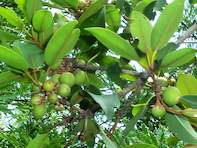Red Milkwood (Mimusops zeyheri) is also called moepel, Mmupudu, umPushane, Nhlantswa and Mubululu and is native to Africa.

The large shady evergreen Red Milkwood tree is indigenous to the northern parts of South Africa and grows in woodland areas on rocky hillsides, in kloofs and riverine areas in the Limpopo, Gauteng, North West, Mpumalanga, KwaZulu-Natal and Free State provinces.
The leaves are eaten by antelope and elephant while the fruit is relished by monkeys, bush pigs and humans. The Red Milkwood fruit is sweet and high in vitamin C (ranges from 50-90 mg per 100 g) and is ready to harvest from April to October when it loses the sticky latex present in the skin and flesh of the unripe fruit. (Latex is a milky fluid secreted by a plant when it is damaged). The oval orange fruit can be harvested half-ripe and will ripen within one to five days.
The Red Milkwood tree is easily cultivated from seeds and prefers frost-free summer rainfall regions. It has non-aggressive roots, is frost and drought resistant and due to the presence of latex the Red Milkwood does not have many pests. Red Milkwood is suitable for clay and loam soils and pruning is necessary for optimal fruit production.
Red Milkwood has a high potential to serve in economic and nutritional projects in arid and semi-arid regions. A study to determine the selection of an indigenous fruit tree for domestication and commercialisation identified the Red Milkwood as the favourite (92.5%) to plant compared to 64% of the farmers who would also consider planting mobola plum.
Farmers in all regions felt that there was a great need for the domestication and commercialisation of Red Milkwood trees “because these fruit trees were scarce in nature as opposed to marula”.
Benefits of Red Milkwood
Red Milkwood fruit has the potential for alleviating vitamin C deficiencies, particularly as the fruits occur in mid-spring when vitamin C in rural areas is in short supply. The fruits are processed into a traditional dried pulp called “sesema” which has a long shelf life and serves as a tasty food during winter.